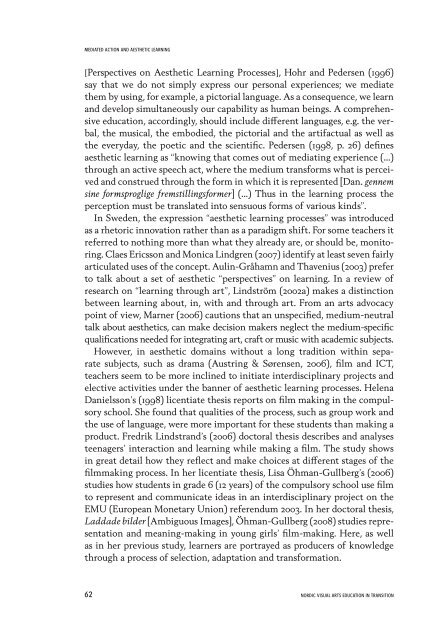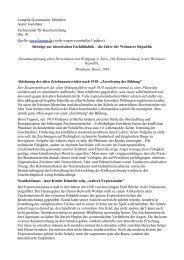Research in Visual Arts Education - The National Society for ...
Research in Visual Arts Education - The National Society for ...
Research in Visual Arts Education - The National Society for ...
Create successful ePaper yourself
Turn your PDF publications into a flip-book with our unique Google optimized e-Paper software.
MEDIATED ACTION AND AESTHETIC LEARNING<br />
[Perspectives on Aesthetic Learn<strong>in</strong>g Processes], Hohr and Pedersen (1996)<br />
say that we do not simply express our personal experiences; we mediate<br />
them by us<strong>in</strong>g, <strong>for</strong> example, a pictorial language. As a consequence, we learn<br />
and develop simultaneously our capability as human be<strong>in</strong>gs. A comprehensive<br />
education, accord<strong>in</strong>gly, should <strong>in</strong>clude different languages, e.g. the verbal,<br />
the musical, the embodied, the pictorial and the artifactual as well as<br />
the everyday, the poetic and the scientific. Pedersen (1998, p. 26) def<strong>in</strong>es<br />
aesthetic learn<strong>in</strong>g as “know<strong>in</strong>g that comes out of mediat<strong>in</strong>g experience (…)<br />
through an active speech act, where the medium trans<strong>for</strong>ms what is perceived<br />
and construed through the <strong>for</strong>m <strong>in</strong> which it is represented [Dan. gennem<br />
s<strong>in</strong>e <strong>for</strong>msproglige fremstill<strong>in</strong>gs<strong>for</strong>mer] (…) Thus <strong>in</strong> the learn<strong>in</strong>g process the<br />
perception must be translated <strong>in</strong>to sensuous <strong>for</strong>ms of various k<strong>in</strong>ds”.<br />
In Sweden, the expression “aesthetic learn<strong>in</strong>g processes” was <strong>in</strong>troduced<br />
as a rhetoric <strong>in</strong>novation rather than as a paradigm shift. For some teachers it<br />
referred to noth<strong>in</strong>g more than what they already are, or should be, monitor<strong>in</strong>g.<br />
Claes Ericsson and Monica L<strong>in</strong>dgren (2007) identify at least seven fairly<br />
articulated uses of the concept. Aul<strong>in</strong>-Gråhamn and Thavenius (2003) prefer<br />
to talk about a set of aesthetic “perspectives” on learn<strong>in</strong>g. In a review of<br />
research on “learn<strong>in</strong>g through art”, L<strong>in</strong>dström (2002a) makes a dist<strong>in</strong>ction<br />
between learn<strong>in</strong>g about, <strong>in</strong>, with and through art. From an arts advocacy<br />
po<strong>in</strong>t of view, Marner (2006) cautions that an unspecified, medium-neutral<br />
talk about aesthetics, can make decision makers neglect the medium-specific<br />
qualifications needed <strong>for</strong> <strong>in</strong>tegrat<strong>in</strong>g art, craft or music with academic subjects.<br />
However, <strong>in</strong> aesthetic doma<strong>in</strong>s without a long tradition with<strong>in</strong> separate<br />
subjects, such as drama (Austr<strong>in</strong>g & Sørensen, 2006), film and ICT,<br />
teachers seem to be more <strong>in</strong>cl<strong>in</strong>ed to <strong>in</strong>itiate <strong>in</strong>terdiscipl<strong>in</strong>ary projects and<br />
elective activities under the banner of aesthetic learn<strong>in</strong>g processes. Helena<br />
Danielsson’s (1998) licentiate thesis reports on film mak<strong>in</strong>g <strong>in</strong> the compulsory<br />
school. She found that qualities of the process, such as group work and<br />
the use of language, were more important <strong>for</strong> these students than mak<strong>in</strong>g a<br />
product. Fredrik L<strong>in</strong>dstrand’s (2006) doctoral thesis describes and analyses<br />
teenagers’ <strong>in</strong>teraction and learn<strong>in</strong>g while mak<strong>in</strong>g a film. <strong>The</strong> study shows<br />
<strong>in</strong> great detail how they reflect and make choices at different stages of the<br />
filmmak<strong>in</strong>g process. In her licentiate thesis, Lisa Öhman-Gullberg’s (2006)<br />
studies how students <strong>in</strong> grade 6 (12 years) of the compulsory school use film<br />
to represent and communicate ideas <strong>in</strong> an <strong>in</strong>terdiscipl<strong>in</strong>ary project on the<br />
EMU (European Monetary Union) referendum 2003. In her doctoral thesis,<br />
Laddade bilder [Ambiguous Images], Öhman-Gullberg (2008) studies representation<br />
and mean<strong>in</strong>g-mak<strong>in</strong>g <strong>in</strong> young girls’ film-mak<strong>in</strong>g. Here, as well<br />
as <strong>in</strong> her previous study, learners are portrayed as producers of knowledge<br />
through a process of selection, adaptation and trans<strong>for</strong>mation.<br />
62 NORDIC VISUAL ARTS EDUCATION IN TRANSITION



